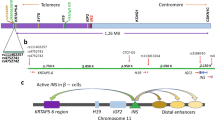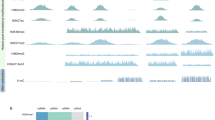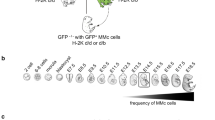Abstract
Although there is strong evidence that the paternal genome is activated at the four- to eight-cell stage of mouse embryogenesis1–12, studies to date have been restricted because of their dependence on the manifestations of gene products, such as enzyme activity and cell-surface expression, rather than on direct assay of their synthesis. β2-microglobulin (β2M), a 12,000-molecular weight (Mr) peptide associated with several of the gene products encoded by the H–2–Tla complex in the mouse13–17, is synthesized by early cleavage stage embryos (J.A.S., T.M. and C.J.E., unpublished). The existence of an electrophoretic variant of β2M in inbred strains has recently been described18–20, and tryptic peptide mapping19 and amino acid sequencing data21 indicate that the primary sequences of these variants differ by a single amino acid, thus establishing the genetic basis for this variation. Mice heterozygous at the β2m locus synthesize both forms, β2Ma and β2Mb (refs 18, 20). Using direct immunoprecipitation and two-dimensional gel electrophoresis, we have used this variation at the β2m locus to distinguish between maternal and paternal β2M and have now established that the synthesis of paternally derived β2M is first detectable at the two-cell stage. This is the earliest stage at which expression of the mammalian embryonic genome has been established22.
This is a preview of subscription content, access via your institution
Access options
Subscribe to this journal
Receive 51 print issues and online access
$199.00 per year
only $3.90 per issue
Buy this article
- Purchase on Springer Link
- Instant access to full article PDF
Prices may be subject to local taxes which are calculated during checkout
Similar content being viewed by others
References
Epstein, C. J. Science 175, 1467–1468 (1972).
Brinster, R. L. Biochem. Genet. 9, 187–191 (1973).
Krco, C. J. & Goldberg, E. H. Transplant Proc. 9, 1367–1370 (1977).
Muggleton-Harris, A. L. & Johnson, M. H. J. Embryol. exp. Morph. 35, 59–72 (1976).
Wudl, L. & Sherman, M. I. Cell 9, 523–531 (1976).
Adler, D. A., West, J. D. & Chapman, V. M. Nature 267, 838–839 (1977).
Epstein, C. J., Smith, S., Travis, B. & Tucker, G. Nature 274, 500–503 (1978).
Kratzer, P. G. & Gartler, S. M. Nature 274, 503–504 (1978).
Monk, M. in Development in Mammals Vol. 1 (ed. Johnson, M. H.) 189–223 (North-Holland, Amsterdam, 1978).
Monk, M. & Harper, M. J. Embryol. exp. Morph. 46, 53–64 (1978).
Epstein, C. J., Smith, S. & Travis, B. Tissue Antigens 15, 63–67 (1980).
Esworthy, S. & Chapman, V. M. Devl Genet. 2, 1–12 (1981).
Rask, L., Lindblom, B. & Peterson, P. A. Nature 249, 833–834 (1974).
Silver, J. & Hood, L. Nature 249, 764–765 (1974).
Armeding, D., Kubo, R. T., Grey, H. M. & Katz, D. H. Proc. natn. Acad. Sci. U.S.A. 72, 4577–4581 (1975).
Capra, J. D., Vitetta, E. & Klein, J. J. exp. Med. 142, 664–672 (1975).
Vitetta, E., Uhr, J. W. & Boyse, E. A. J. Immun. 114, 252–254 (1975).
Michaelson, J., Rothenberg, E. & Boyse, E. A. Immunogenetics 11, 93–95 (1980).
Robinson, P. J., Graf, L. & Sege, K. Proc. natn. Acad. Sci. U.S.A. 78, 1167–1170 (1981).
Goding, J. W. & Walker, I.D. Proc. natn. Acad. Sci. U.S.A. 77, 7395–7399 (1980).
Gates III, F. T., Coligan, J. E. & Kindt, T. J. Proc. natn. Acad. Sci. U.S.A. 78, 554–558 (1981).
Magnuson, T. R. & Epstein, C. J. Biol. Rev. 56, 369–408 (1981).
Sawicki, J. A. & Epstein, C. J. Immunogenetics 12, 141–151 (1981).
O'Farrell, P. H. J. biol. Chem. 250, 4007–4021 (1975).
O'Farrell, P. Z., Goodman, H. M. & O'Farrell, P. H. Cell 12, 1133–1142 (1977).
Epstein, C. J., Wegienka, A. & Smith, C. W. Biochem. Genet. 3, 271–281 (1969).
Golbus, M. S. & Epstein, C. J. Differentiation 2, 143–149 (1974).
Author information
Authors and Affiliations
Rights and permissions
About this article
Cite this article
Sawicki, J., Magnuson, T. & Epstein, C. Evidence for expression of the paternal genome in the two-cell mouse embryo. Nature 294, 450–451 (1981). https://doi.org/10.1038/294450a0
Received:
Accepted:
Issue Date:
DOI: https://doi.org/10.1038/294450a0
This article is cited by
-
Heterosis in plants: Manifestation in early seed development and prediction approaches to assist hybrid breeding
Chinese Science Bulletin (2009)
-
Preimplantation mouse embryos express Mhc class I genes before the first cleavage division
Immunogenetics (1993)
-
Developmental and tissue-specific expression of the Q5 k gene
Immunogenetics (1991)
-
β2-Microglobulin deficient mice lack CD4−8+ cytolytic T cells
Nature (1990)
-
Germ-line transmission of a disrupted β2microglobulin gene produced by homologous recombination in embryonic stem cells
Nature (1989)
Comments
By submitting a comment you agree to abide by our Terms and Community Guidelines. If you find something abusive or that does not comply with our terms or guidelines please flag it as inappropriate.



